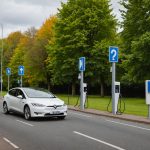Winter poses unique challenges for hybrid vehicle owners, particularly concerning fuel efficiency. With colder temperatures driving up energy consumption, UK residents need practical strategies to optimize their driving experience. This guide offers essential tips to enhance your hybrid's fuel economy during winter months. Discover how minor adjustments in driving habits and vehicle maintenance can lead to significant savings and a smoother ride. Embrace winter driving with these actionable insights to make every journey cost-effective and efficient.
Understanding Winter Fuel Efficiency Challenges
Winter conditions can significantly impact fuel efficiency, particularly for hybrid vehicles. Cold temperatures can cause engines to run less efficiently, leading to increased fuel consumption. Snow and ice on the roads create additional resistance, requiring more energy to maintain speed and traction. These factors combined can reduce the overall efficiency of vehicles during the winter months.
Also read : Understanding the Impact of UK Seasonal Variations on Electric Vehicle Battery Efficiency
For drivers of hybrid vehicles, these challenges are compounded. Hybrids rely on both electric and gasoline power, and cold weather can affect battery performance, reducing the electric range and increasing dependence on the gasoline engine. Moreover, heaters and defrosters, essential in cold weather, draw additional power from the vehicle's systems, further impacting fuel efficiency.
Addressing these challenges is crucial not only for maintaining optimal vehicle performance but also for cost savings. Efficient fuel use during winter can lead to significant savings over time, making it essential for drivers to adapt their driving habits and vehicle maintenance routines to the season.
In the same genre : Exploring Cutting-Edge Innovations in Autonomous Vehicle Technology for the UK Market
Vehicle Maintenance for Optimal Efficiency
To ensure optimal efficiency during the winter months, regular vehicle maintenance is essential. Cold weather poses unique challenges that can affect the performance of your hybrid vehicle, making upkeep even more critical.
Importance of Regular Maintenance Checks
Regular maintenance checks are crucial during winter to prevent unexpected breakdowns and maintain fuel efficiency. Components such as the engine, tires, and fluids require extra attention. Ensuring that the engine is running smoothly can help mitigate the increased fuel consumption caused by cold temperatures. Additionally, checking tire pressure is vital, as it can drop in cold weather, affecting traction and efficiency.
Specific Maintenance Practices for Hybrid Vehicles
Hybrid vehicles require specific maintenance practices to cope with winter challenges. It's important to monitor the battery's health, as cold temperatures can significantly reduce its performance. Keeping the battery warm, either by parking in a garage or using a battery heater, can help maintain its efficiency. Furthermore, ensuring that the hybrid system is functioning correctly will minimize the reliance on the gasoline engine, thus preserving fuel efficiency.
Tips for Ensuring Battery Performance and Longevity
To enhance battery performance and longevity in low temperatures, consider the following tips:
- Precondition the vehicle: Use the vehicle's preconditioning feature to warm up the battery before driving.
- Limit short trips: Short trips prevent the battery from reaching optimal operating temperature.
- Regularly check battery health: Regular inspections can help identify potential issues early.
By following these maintenance practices, drivers can not only improve their vehicle's efficiency but also ensure a smoother and safer driving experience throughout the winter season.
Effective Driving Techniques in Winter
Navigating winter roads demands a shift in driving techniques to maintain fuel efficiency. Adopting the right habits can significantly enhance your vehicle's performance during the colder months.
Recommended Driving Habits
To improve fuel-efficient driving in winter, consider adjusting your driving style. Avoid rapid acceleration and harsh braking, as these can lead to increased fuel consumption. Instead, practice smooth and gradual acceleration to maintain traction on icy surfaces. Additionally, anticipate stops and apply brakes gently to prevent skidding and save fuel.
Strategies for Smooth Acceleration and Braking
Smooth acceleration and braking are crucial in winter conditions. Start by gently applying the gas pedal to allow your vehicle to build up speed gradually. This method not only conserves fuel but also reduces the risk of losing control on slippery roads. Similarly, when slowing down, ease off the accelerator and apply the brakes softly. This approach helps in maintaining stability and fuel efficiency.
Utilizing Hybrid Vehicle Features
Hybrid vehicles offer features that can be optimized for better performance in the cold. Use the vehicle's eco-mode to maximize fuel efficiency by adjusting power distribution between the electric motor and gasoline engine. Additionally, regenerative braking can be particularly beneficial in winter, as it helps recharge the battery while reducing wear on the brake system. Embracing these features can lead to a more efficient and safe winter driving experience.
Fuel Management Strategies
Efficient fuel management is vital for maintaining hybrid fuel efficiency during the winter months. Cold weather can significantly impact fuel consumption, making it essential to adopt effective winter fuel tips.
Best Practices for Refueling and Fuel Choice
In winter, choosing the right fuel and refueling practices can enhance efficiency. Opt for high-quality gasoline, as it contains fewer impurities and can improve performance in cold weather. Additionally, keep your fuel tank more than half full to prevent moisture accumulation, which can freeze and block fuel lines.
Understanding Cold Weather's Impact on Fuel Consumption
Cold temperatures increase fuel consumption due to several factors. Engines require more energy to reach optimal operating temperatures, and the increased use of heaters and defrosters adds to the load. Understanding these effects can help drivers adjust their habits to mitigate increased fuel use.
Tips for Maximizing Fuel Economy in Hybrid Vehicles
To maximize fuel economy in hybrid vehicles during winter, consider these strategies:
- Precondition your vehicle: Warming up the vehicle before driving reduces the energy needed to heat the cabin, conserving fuel.
- Drive smoothly: Avoid abrupt starts and stops to maintain efficiency.
- Utilize eco-mode: This feature optimizes power distribution, enhancing fuel economy.
By implementing these fuel management strategies, drivers can improve their vehicle's performance and efficiency throughout the colder months.
Adapting to Cold Weather Conditions
Navigating winter roads requires careful cold weather adaptations to ensure safety and efficiency. Drivers must equip themselves with the right tools and adjust their habits to tackle icy and snowy conditions effectively.
Essential Gear and Tools for Winter Driving
Equipping your vehicle with essential winter gear is crucial. Items such as snow tires, ice scrapers, and emergency kits can make a significant difference. Snow tires provide better traction on icy roads, reducing the risk of skidding. An ice scraper is essential for maintaining clear visibility, while an emergency kit, including blankets, flashlights, and a first-aid kit, ensures preparedness for unexpected situations.
Adjusting Driving Habits for Icy and Snowy Roads
Driving adaptations are key to maintaining control and safety in winter. It is important to reduce speed and increase the following distance to allow for longer stopping times on slippery surfaces. Avoiding sudden movements, such as sharp turns or abrupt braking, can help prevent loss of traction. Instead, use gentle steering inputs and gradual acceleration to maintain stability.
Importance of Planning Routes and Understanding Traffic Conditions in Winter
Planning your route in advance is vital during winter. Check weather forecasts and traffic updates to avoid hazardous conditions. Understanding traffic patterns can help you select safer routes, minimizing the risk of accidents. Additionally, allowing extra travel time can reduce stress and ensure you reach your destination safely. By integrating these winter driving safety strategies, drivers can enhance their safety and efficiency on the road.
User Experiences and Testimonials
Real-life experiences from hybrid vehicle drivers provide valuable insights into achieving winter fuel efficiency. These testimonials highlight practical strategies and offer a glimpse into the challenges faced during colder months.
Collection of Testimonials from UK Hybrid Vehicle Drivers
Hybrid vehicle owners across the UK have shared their experiences with winter driving. Many drivers emphasize the importance of preconditioning the vehicle to ensure the battery operates efficiently in low temperatures. This practice not only enhances battery life but also contributes to better fuel economy. Others have noted the benefits of using eco-mode to optimize power distribution, which helps in maintaining efficiency despite the increased energy demands of winter.
Case Studies Demonstrating Successful Strategies
Several case studies illustrate how hybrid drivers successfully navigate winter challenges. For instance, a driver in Scotland reported a 15% improvement in fuel efficiency by regularly checking tire pressure and using high-quality gasoline. Another driver in London found that limiting short trips and ensuring the battery was adequately warmed before use significantly reduced fuel consumption.
Insights from Experts on the Impact of Winter on Hybrid Vehicle Performance
Experts agree that winter conditions pose unique challenges for hybrid vehicles. They recommend maintaining regular vehicle maintenance and adopting specific driving habits to mitigate the effects of cold weather. By following expert advice, drivers can enhance their vehicle's performance and efficiency during the winter months.
Additional Resources and Tools
Enhancing fuel efficiency and safe driving during winter can be supported by a variety of resources for hybrid drivers. These tools not only provide valuable insights but also help in maintaining optimal vehicle performance.
Recommended Tools and Apps for Tracking Fuel Efficiency
For hybrid vehicle owners seeking to improve their fuel efficiency, several apps can be invaluable. Apps like Fuelly and MyCarTracks allow drivers to monitor fuel consumption, track maintenance schedules, and receive tips for efficient driving. These tools help in identifying patterns and areas for improvement, ensuring that drivers can make informed decisions about their driving habits.
Links to Relevant Guides and Manuals for Hybrid Vehicle Maintenance
Access to comprehensive guides and manuals is crucial for maintaining a hybrid vehicle, especially in winter. Resources such as the Hybrid Owners Manual and manufacturer-specific maintenance guides provide detailed instructions on upkeep and troubleshooting. These documents are essential for understanding the unique maintenance needs of hybrid systems, particularly in cold weather conditions.
Government and Community Resources for Winter Driving Safety and Efficiency
Government and community resources play a significant role in promoting winter driving safety. Websites like the UK Government's winter travel advice page offer updates on road conditions, while local community groups provide real-time information and support. Engaging with these resources ensures that drivers are well-prepared for winter challenges, enhancing both safety and efficiency on the roads.











